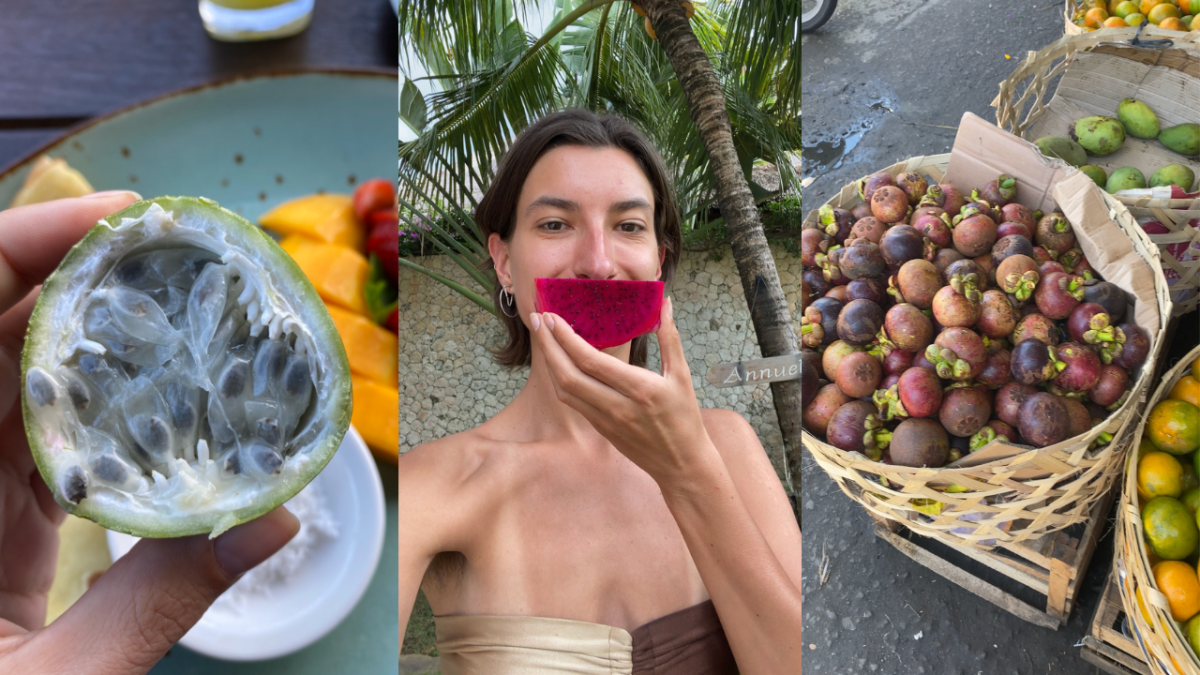
On a recent trip to Indonesia, one of Australia’s closest neighbours, I gorged myself on tropical fruits knowing it would be a while before I’d find them again. It got me thinking. Why is it that in Australia we can buy grapefruits year-round thanks to seasonal shipments from farms in California; pomegranates imported from India are in ready supply, but the most delicious tropical fruits are impossible to find?
Supermarket shelves are mostly dedicated to European fruits like apples and oranges. Yet one-quarter of Australia’s landmass is considered tropical or subtropical and many of the so-called “exotic” fruits we eat on overseas holidays like dragonfruit, mangosteens, rambutan, soursop, snake fruit, jackfruit and durian grow well in parts of Far North Queensland the Northern Territory and even New South Wales.
“The supply is there but it’s not enough. The demand is outstripping supply,” Zona Tan-Sheppard, founder of tropical fruit distributor The Thorny Fruit Co, told PEDESTRIAN.TV.
Tan-Sheppard grew up in Malaysia but has lived in Sydney for more than a decade and said as Australia’s Asian population has grown, so too has the demand for tropical fruits.
“I’m part of a Facebook migrant community and, as usual, everyone who was South-East Asian was asking ‘where do I find these ingredients?’” she said.
In 2018 she found a durian farm in the NT set up by a Malaysian family in the 1990s and wanted to put in a wholesale order, but the minimum was 20kgs. So she asked the Facebook group.
“20kgs became an order of 400kgs,” she said.
“Immediately people started asking, ‘can you get mangosteens? Can you get pomelos?’”
So in 2019 she launched her business, but she soon realised just how many roadblocks stood in the way of Australians’ reliable access to tropical fruits.
Tropical fruits have short seasons and need a stable climate
Our fledging tropical fruit industry is highly diverse, worth more than $10 million annually and offers more than 60 tropical fruits. But in terms of scale, it’s largely outshone by massive commercial farms dedicated to sugarcane, Cavendish bananas and a couple of varieties of mangoes.
They’re relatively cheap to farm because they have very long harvest seasons — between six and 12 months long — and produce viable yields within two years of planting. Durian, on the other hand, is only in season for a few weeks and the trees take up to 20 years to mature and produce fruit.
“For many Australian-grown tropical fruits, the season is short so we are unable to sell these items for longer than a few months,” a Coles spokesperson told PEDESTRIAN.TV.
“The demand for tropical fruits is growing as more customers look to sample and cook with new ingredients. Where possible, we import some tropical fruit when locally grown fruit is out of season.”
A spokesperson for Woolworths also told PEDESTRIAN.TV it only stocked tropical fruits when they’re available from local growers, rather than importing. And because tropical fruits weren’t as popular in store as apples, bananas and citrus, supply was also dependent on customer demand.
The people in charge aren’t familiar with tropical fruits
Tan-Sheppard said although demand was growing, the majority of the population as well as the people who run supermarket chains and markets were still largely unfamiliar with Asian fruits.
When shopping for durian at wholesale markets she said she often sees different varieties from various Australian growers all mixed up together, when they should be separated and priced by grade.
“A lot of these wholesalers don’t understand these fruits … and they will only sell what they see as in demand from their shops. But once I tapped into [online communities] it opened the floodgates of demand,” she said.
Logistics — Australia’s big, and importing tropical fruits doesn’t always work
Many tropical fruits are very sensitive to temperature changes and some don’t last long off the tree. Refrigeration requirements, biosecurity regulations and the sheer size of Australia mean that transporting fruit fresh can be very difficult and costly.
“Darwin to Sydney is a four-day road freight. From Far North Queensland where the majority of tropical fruit is grown to Sydney takes two days. The amount of time to road freight is equivalent to travelling from Singapore to Laos,” Tan-Sheppard said.
“Airfreight, the volume is not enough to make ends meet. We’d be paying $100 per kg for fruit if it was airfreighted from Queensland to Sydney.”
But what about Asian imports?
All fruit imports have to go through biosecurity screening upon arrival. Most will pass — this isn’t the problem. The issue is they need to be refrigerated for the duration of transit and unfortunately some tropical fruits just can’t handle the cold.
Tan-Sheppard said soursops are practically impossible to find in Australia because if they’re in the fridge overnight they turn black. Mangosteens also turn hard in the fridge so the risk of having to throw out rancid tropical fruit is higher than other fruits commonly imported from overseas, like citrus.
Some producers and distributors have calculated that it’s worth the risk, but our friend COVID flipped that on its head.
“Pre-COVID mangosteens from Thailand were $20 per kg … After COVID when all the airlines shutdown they went up over $50 per kg, so Australian mangosteens have now ended up cheaper,” Tan-Sheppard said.
So what’s the answer?
Basically, investment in local industries. Flying any fresh produce around the world is costly, spews carbon emissions and, especially in the case of tropical fruits, leads to an inferior product. If governments were to invest in local tropical fruit farms, and supermarkets and wholesalers committed to buying stock, we could have an array of delicious and affordable fruits on offer for which demand would only continue to rise.
“We need government involvement,” Tan-Sheppard said.
“It’s become up to individual investors and farmers to do it themselves. The system’s a bit broken.”
But some industry bodies are pushing for change.
AgriFutures Australia created an Australian Emerging Tropical Fruits Strategic RD&E Plan in December 2021 which identified five “emerging tropical fruits” with market growth potential — jackfruit, rambutan, durian, dragon fruit and longan — and outlined a plan to get them in more people’s shopping bags.
“The Plan is a valuable resource that the emerging tropical fruits industry can use to promote itself to investors, stakeholders and other industries” AgriFutures Emerging Industries Program Manager Laura Skipworth said.
The organisation hopes the plan can centralise efforts to help to build a stronger and more resilient tropical fruit industry.
“While the vastness of the Northern Australia region comes with many challenges including workforce, transport and logistics, we’ve seen other industries perform successfully, so there’s a real sense that one or more of these emerging tropical fruits might be the next up-and-coming tropical fruit crop.”
Now please someone give me a million dollars and I’ll set up a mangosteen farm myself.



